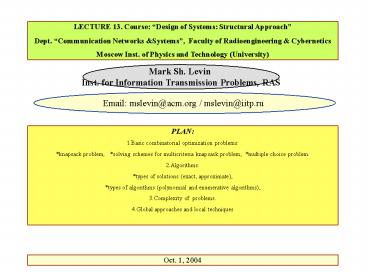LECTURE 13. Course: - PowerPoint PPT Presentation
Title:
LECTURE 13. Course:
Description:
Dept. 'Communication Networks &Systems', Faculty of ... 1.Ordering by decreasing of ci / ai (algorithm by Danzig, heuristic) 2.Branch-And-Bound method ... – PowerPoint PPT presentation
Number of Views:20
Avg rating:3.0/5.0
Title: LECTURE 13. Course:
1
LECTURE 13. Course Design of Systems
Structural Approach Dept. Communication
Networks Systems, Faculty of Radioengineering
Cybernetics Moscow Inst. of Physics and
Technology (University)
Mark Sh. Levin Inst. for Information
Transmission Problems, RAS
Email mslevin_at_acm.org / mslevin_at_iitp.ru
PLAN 1.Basic combinatorial optimization
problems knapsack problem, solving
schemes for multicriteria knapsack problem,
multiple choice problem. 2.Algorithms types
of solutions (exact, approximate), types of
algorithms (polynomial and enumerative
algorithms), 3.Complexity of problems. 4.Global
approaches and local techniques
Oct. 1, 2004
2
Knapsack problem
. . .
. . .
- i
m (index) - a1 ai
am (required
resource) - c1 ci
cm (utility /
profit) - x1 xi
xm (Boolean
variable)
max ?mi1 ci xi s.t. ?mi1 ai
xi ? b xi ? 0, 1, i 1, , m
possible additional constraints ?mi1 aik
xi ? bk , k 1, , l
3
Algorithms for knapsack problem
1.Ordering by decreasing of ci / ai (algorithm
by Danzig, heuristic) 2.Branch-And-Bound
method 3.Dynamic programming (exact
solution) 4.Dynamic programming (approximate
solving scheme) 5.Probabilistic
methods 6.Hybrid schemes
4
Simple versions of knapsack problem
1. ci co (equal utilities) 2. ai
ao (equal required resources)
Polynomial algorithm 1. ordering by
non-decreasing of ai 2. ordering by
non-increasing of ci
5
Extended versions of knapsack problem
1.Knapsack problem with objective function as
min
2.Knapsack problem with several
knapsacks
3.Knapsack problem with additional
structural (logical) constraints over
elements (e.g., some kinds of trees)
4.Multi-objective knapsack problem
5.Knapsack problem with fuzzy parameters
6
Heuristic solving scheme for multicriteria
(multiple objective) versions of knapsack problem
ALGORITM SCHEME (case of linear ranking)
STEP
1.Multicriteria ranking of elements (to obtain
linear ranking) STEP 2.Series
selection of elements
(the best
element, the next element, etc.)
After each selection
testing the resource constraint ( ? b ).
If the constraint is not right it is necessary to
delete the last selected element and to
STOP.
Else to STEP 2.
STOP.
Selection testing (Step 2)
Linear ranking
Selection testing (Step 2)
Selection testing (Step 2)
7
Heuristic solving scheme for multicriteria
(multiple objective) versions of knapsack problem
ALGORITM SCHEME (case of group ranking)
STEP
1.Multicriteria ranking of elements (to obtain
group ranking) STEP 2.Series selection
of elements
(elements of the best
group, elements of the next group, etc.)
After each selection testing the resource
constraint ( ? b ). If the constraint is
not right it is necessary to go to STEP 3. Else
to STEP 2.
STEP 3. Solving
for the last analyzed element group the special
case of knapsack problem (with equal utilities)
as series selection of elements from the
list ( non-increasing by ai ).
Here constraint is the following ? b -
?(i?Q) ai
(where Q is a set of selected elements from the
previous groups) STOP.
Selection testing (Step 2)
Selection testing (Step 2)
Group ranking
Constraint is not right, go to Step 3
8
Multiple choice problem
. . .
. . .
. . .
. . .
. . .
J1 Ji
Jm
? i Ji qi , j 1, , qi
max ?mi1 ?qij1 cij xij s.t. ?mi1
?qij1 aij xij ? b ?qij1 xij
? 1 , i 1, , m xij ? 0, 1, i 1,
, m , j 1, , qi
9
Algorithms for multiple choice problem (as for
knapsack problem)
1.Ordering by decreasing of cij / aij
(heuristic) 2.Branch-And-Bound method 3.Dynamic
programming (exact solution) 4.Dynamic
programming (approximate solving
scheme) 5.Probabilistic methods 6.Hybrid schemes
10
Illustration for dynamic programming
Series Design of a Solution
1.From START point to END point
2.From END point to START point
END point
START point
Search Space
11
Illustration for complexity of combinatorial
optimization problems
TSP
Clique problem
Morphological clique problem
Quadratic assignment problem
NP-hard problems
Multiple choice problem
Approximate polynomial solvable problems
Knapsack problem
Polynomial solvable problems
12
Classification of algorithms
BY EXACTNES OF RESULT (solution)
1.Exact solution
2.Approximate solution
(for worst case)
limited error
(absolute error) limited error (relative error)
other situations 3.Approximate solution
(statistically)
4.Heurstic
(without an estimate of exactness)
BY COMPLEXITY OF SOLVING PROCESS (e.g., number of
steps) 1.Polynomial algorithms
(of length of input, for example
O(n log n)), O(n), O(1),
O(n2) 2.Polynomial approximate
schemes (for a specified exactness / limited
error, for example O(n2/? ) where ? ? 0,1
is a relative error for objective
function) 3.Statistically good algorithms
(statistically polynomial ones)
4.Enumerative algorithms
. . .
BASIC ALGORITHM RESOURCES
1.Number of steps (computing operations)
2.Required volume of memory
3.Required number of
interaction with specialists (oracle)
(to get additional
information)
4.Required
communication between processors (for
multi-processor algorithms)
13
Global approaches and local techniques
GLOBAL APPROACHES
1.Partitioning into subproblems
2.Decomposition (extension of
an obtained good local solutions)
(examples dynamic programming,
Branch-And-Bound)
3.Grid method with deletion of bad points
4.Approximation approach (i.e., approximation
of initial problem or its part(s)
by more simple construction(s))
LOCAL TECHNIQUES
1.Local optimization as improvement of
a solution or its part
2.Probabilsitic steps
3.Greedy approach
(selection of the simple / close / etc.
step) 4.Recursion
14
Illustration for improvement of a solution (local
optimization)
INITIAL ROUTE
END point
. . .
START point
LOCAL IMPROVEMENT
LOCAL IMPROVEMENT































